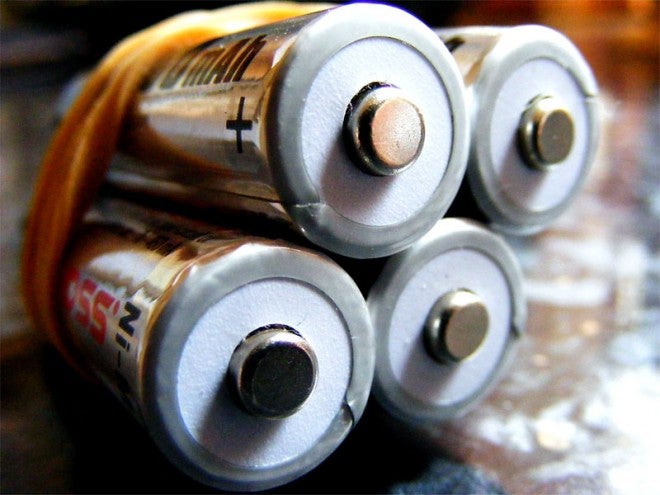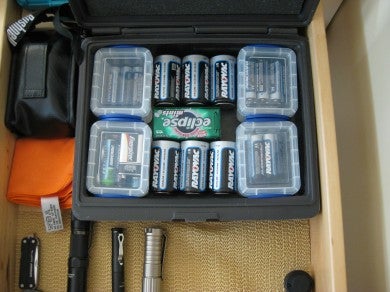Batteries for bomb shelters, Part I
Tony Sculimbrene 09.16.13

There are lots of scenarios where you can imagine not having power for a day or two. In those scenarios batteries aren’t really an issue. Most modern devices that you would reasonably need in a two-day power outage don’t gobble up that batteries. Even portable gaming devices, for kids or to pass the time with, are much better than they used to be. The real challenge comes when you have to plan for longer power outages or for going to places that have no reliable power at all.
There are literally thousands of different kinds and sizes of batteries, but for this article, I am only going to look at the most common cells in their most common application. This means I will be looking at AAA, AA, CR123a, C, and D cells. In an emergency these cells will run things like lights and, via power converters or emergency chargers, your cellphone. Other more energy intensive operations require specific cells.
So let’s take a look a what kinds of batteries you should keep in long-term storage for situations where you may not have access to fresh batteries for a quite a while.
A very short battery primer
Batteries have a set of terms all their own and it is probably worth running through them up front.
First, there are two kinds of batteries–primary cells and rechargeables. Second, there are multiple battery chemistries: alkaline, NiCAD, NiHM, and lithium. Primary cells come in alkaline or lithium chemistries. Rechargeables come in NiCAD, NiHM, and lithium chemistries, though very few devices or companies still make NiCAD batteries.
Third, there are lots of specs for batteries, but if you are looking for batteries for long-term storage, you only need to know three: shelf life (measured in years), overall energy storage (measured in milliamps per hour, abbreviated maH), and energy output (measured in volts).
Primary AA and AAA cells, regardless of whether their chemistry is alkaline or lithium, output 1.5V. Primary CR123a and CR2 cells, which are only available in lithium configurations, output 3.0V. You can get rechargeables that will output energy at many different levels, regardless of size. Finally, rechargeable cells have a specific technical nomenclature, which I’ll explain here in order to help you search for cells online. But after explaining these technical terms I’ll stick to the more normal names for the rest of the article.
We might call them AAA cells, but when they are rechargeable batteries their proper name is a series of numbers. All primary cells have rechargeable cell equivalents with numerical names. The AAA rechargeable cell is a 10440. The naming system is quite ingenious. The first two numbers are the cell’s diameter in millimeters, the second two are its length in millimeters, and the final number, a zero, means that the cell is round. An AA is 14500, a CR2 is a 15270, and a CR123a is a 16340 (though it is sometimes called a RCR123a).
Rechargeable cells come in two configurations for charging and use–protected and unprotected cells. This prevents accidental overcharge or over-discharge in use. Unless you have a good familiarity with the products and know that your device can handle an unprotected cell, it is probably best to opt for the more expensive protected cell. Unprotected cells can put out more energy, but you need a device that can a) handle that increase; and b) has a built in protection device. High end flashlights, such as the Arc 6, can handle unprotected cells.
Finally, though the names are standardized, some rechargeable cells are just slightly larger than their primary cell cousins. You might have to slice off the label (and just the label, unless you want folks to think you’re Walter White) to get the cell to fit.
Medium-term options
Alkaline batteries have come a long way in recent years, moving beyond the gimmicky packaging (remember the squeeze testers that showed up how much life was left?) to include real performance upgrades. But alkalines pale in comparison to lithium chemistry batteries in terms of the three most important criteria for batteries: 1) shelf life; 2) overall energy storage; and 3) energy output. Provided your devices can take the increase, you should stock lithiums as your main “primary” cells. You can find lithium versions of the two regular batteries, AAAs and AAs, but it is much more difficult to find lithium C and D cells. Obviously the CR123a cells are strictly lithium.
In terms of shelf life, there are a few things to consider. First, no cell — primary or rechargeable — will last forever. They all lose power. There are two ways to deal with this, depending on the battery type.
A primary alkaline cell will discharge at a slower rate if it is kept in a refrigerator. The cool temperature is a huge help, but, and this is a crucial point, the low humidity will increase the battery’s resistance over time, meaning that the battery won’t work as well. In order to prevent this from happening, you can store the batteries in a vapor-proof container. Doing that will preserve some of the necessary internal fluids in the battery and allow it to work. This storage method will give you a small advantage, but generally I don’t think it is worth the effort. First, it means that you have to have a working fridge. Second, it means that you are taking up space from food. Third, if the vapor container doesn’t work then the whole thing is shot.
Instead, I think the better option is just to invest in lithiums. They have a much longer shelf life than alkalines, with most having something like 80% of their power after a few years and some high quality ones having that much power after 5 years. Generally, I buy reliable but cheap CR123a batteries, with brands like Titanium. In reality, these will last about 2-3 years in storage or in a low parasitic drain light (most modern lights have a parasitic drain rate that’s below the battery’s discharge rate, meaning they do not tax batteries inside them).
But after 2-3 years, it is a crap shoot. I recently went through a backpack and found old, cheap CR123a batteries. They were more than 3 years old and they were dead as a doornail. But my expensive cells, Duracells and Surefires were still good. In terms of brands, I would recommend Energizers for Lithium AAA and AAs, and Surefires or 47s batteries for CR123a cells. 47s are (or were) a badge swap with the Panasonic lithiums. The reality is that a lot of the CR123a batteries on the market are simply relabels made by Panasonic.
Rechargeable cells are not a good option for medium term storage or “set and forget” storage. Even the best rechargeables can’t hold a charge past 3 years, and the lithium rechargeables die even faster than the slow discharge NiMH batteries in my experience.
Conclusion
In the short and medium term, your best battery options are high quality primary lithium cells. These cells are more expensive, but they have a much longer shelf life than alkalines or rechargeables, much greater power storage capacity, and much higher power output.
When bought in batches over the Internet AA, AAA, and CR123a primary lithiums approach the price of alkalines, costing some where around 25%-30% more. Amazon has a subscription service that can drive the price of cells down even more while keeping you restocked, if that is a concern.
None of these options are really more than a medium term solution. For power in remote places beyond the 5 year mark, you need to get creative. I have thought about this problem a lot and I think I have a flexible solution that I will outline in Part II.
